Skills-based talent management
Discover what a skills-based approach in talent hiring and management is. Learn the key 5 steps on how to implement it in your organization.

In this blog, we’ll dive into how skills-based training management is changing the game for businesses facing a global skills shortage.
Companies are moving away from traditional talent approaches and embracing skills-based training to focus on what employees can actually do, not just their job titles. This shift to skills-based management is all about developing the skills that truly drive success.
Becoming a skills-based organization means prioritizing skills development to stay agile and competitive. It’s about identifying and closing skill gaps, ensuring your team has the right abilities to adapt and thrive. Let’s explore how this approach can transform your workforce and future-proof your business.
In this blog, we will cover:
- What is skills-based talent management?
- Skills-based vs. role-based organizations – what’s the difference?
- The growing importance of skills-based talent management
- Implementing skills-based talent management
- The role of HR and L&D leaders when taking a skills-based approach to talent management
- How learning platforms can support skills-based talent management
What is skills-based talent management?
The trend of managing a workforce through the prism of employee skillsets has gained significant momentum in recent years. The rapid expansion of technology in the workplace and the changing face of work, accelerated by the pandemic, have led to a significant skills shortage worldwide.
Adopting skills-based talent management is crucial to overcome skills shortages.
Companies need agile, employee-centric approaches to workforce management, focusing on assessing employees based on their skills, not job titles or experience.
This approach offers adaptability, better hiring decisions, and personalized training programs. It optimizes the workforce and keeps companies competitive.

How to conduct a skills gap analysis and what to do next
Start building your foundation for strategic workforce development.
Download guideSkills-based organization vs. role-based organization – What’s the difference?
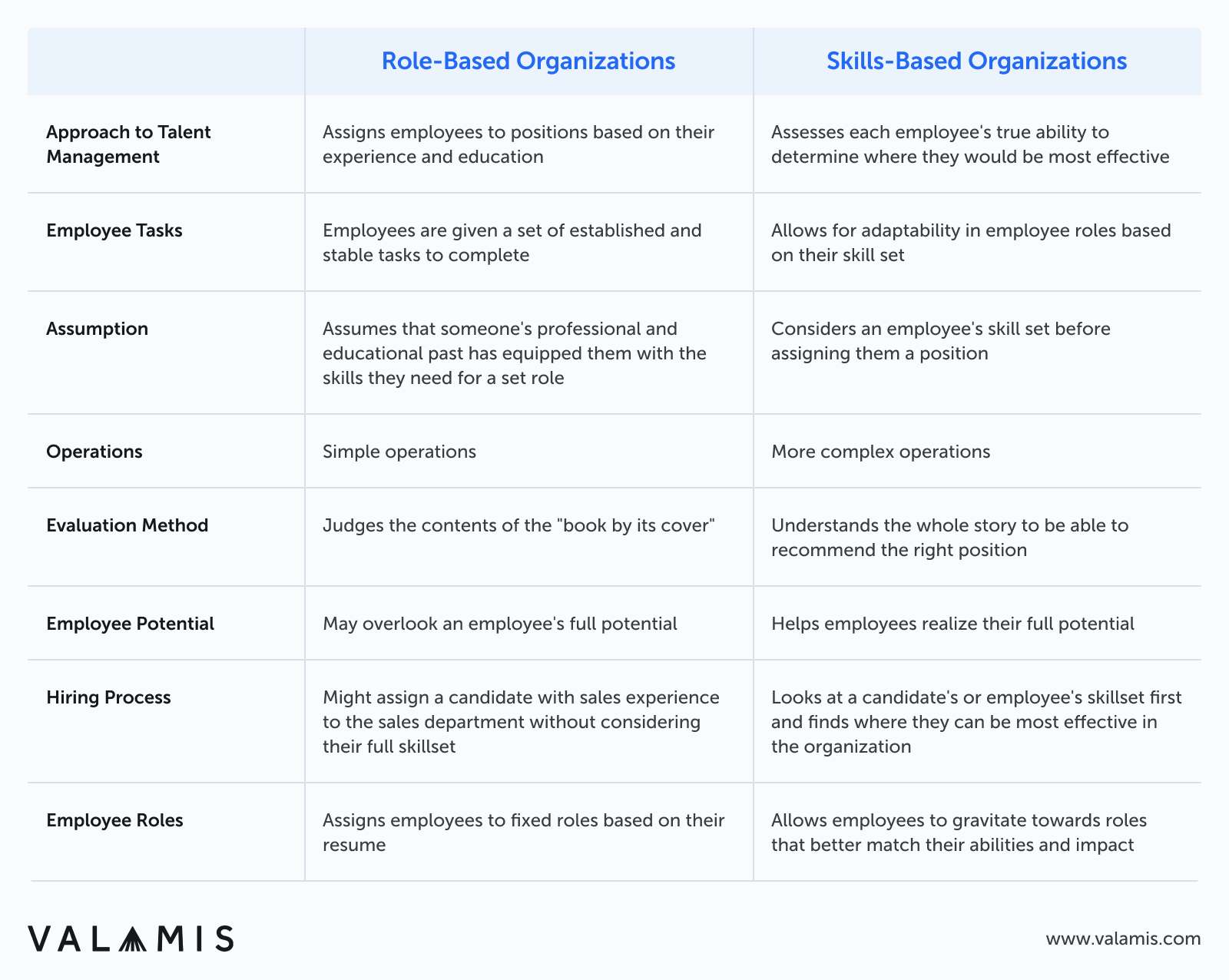
Skills-based organizations (SBOs) apply this style of talent management to their workforce. In contrast, a role-based organization utilizes traditional workplace structures. Employees are assigned a position based on their experience and education and given a set of responsibilities.
Role-based organizations generally have simpler operations, with each employee having a list of established and stable tasks to complete. It relies on the assumption that someone’s professional and educational past has equipped them with the skills they need for a set role.
The difference between the two approaches is that a skills-based approach takes the time to assess the actual ability of each employee to determine where they could be most effective in the workforce, rather than slotting them into a fixed role based on their résumé.
Role-based organizations assume the contents of a book from its cover. Skills-based organizations understand the whole story to be able to recommend it to the right people.
For example, a role-based organization might see a candidate with sales experience and then consider them for a position in their sales department. A skills-based organization would reverse the thought process by first looking at a candidate’s or employee’s skillset, then finding where they can be most effective in the organization.
Someone who combines great people and communication skills with industry knowledge might be initially assigned to the sales team. While working there, they may demonstrate exceptional creativity in developing sales pitches.
These skills could be better suited to designing advertising content, and they start gravitating toward marketing tasks, where their abilities have a more significant impact.
The growing importance of skills-based talent management
The way we work is changing rapidly. With the integration of new technologies and remote work becoming more common, workers must continually develop their skillset to remain viable employees. Meanwhile, organizations must find ways to build the skills they need to succeed.
According to LinkedIn’s 2023 workplace learning report, working skill sets have changed by 25% since 2015 and are expected to double by 2027. IBM research shows that the half-life of skills has dropped from 10-15 years to just five years, with technical skills becoming obsolete even faster.
To stay ahead in today’s rapidly evolving business world, organizations must prioritize hiring and developing employees based on their skills, not just their work history. This means significant upskilling and reskilling programs and transitioning from a role-based talent management approach to a skills-based one.
Evaluating and developing employees based on their knowledge and capabilities rather than their work history has significant upsides.
Analysis by Deloitte shows the benefits of transitioning to a skills-based organization:
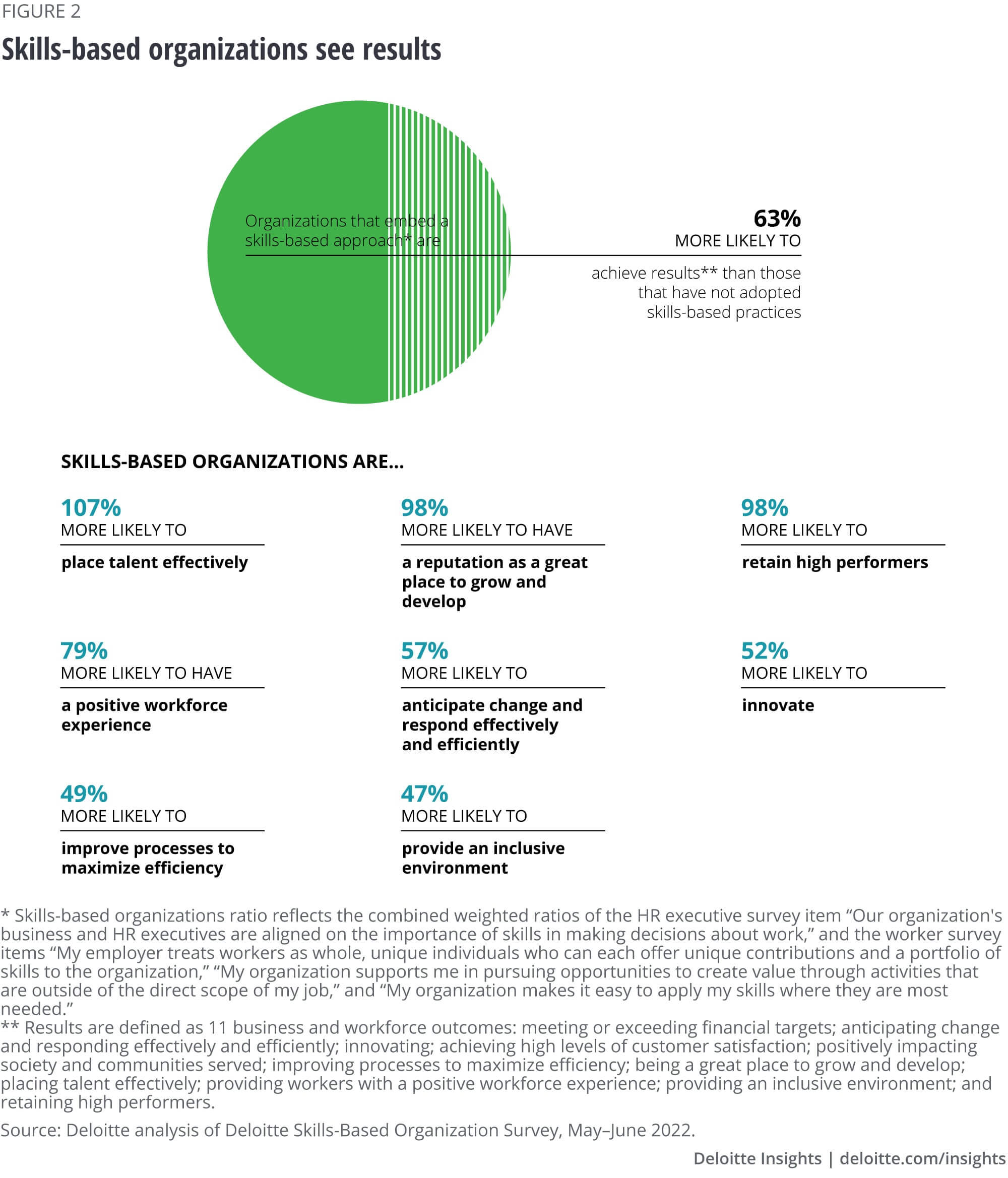
1. Organizational agility
Deloitte surveys show that 85% of business executives believe organizations need more agile ways of organizing work due to recent changes. Organizational agility means a company can adapt quickly and stay ahead in a fast-paced world.
Skills-based talent management is key to achieving this agility. When businesses understand their workforce’s skills, they can quickly address gaps with L&D programs or shift employees to fit new strategies.
It’s a win-win: companies stay flexible, and employees gain career growth. Embracing continuous learning and fostering learning cultures put employee development at the heart of business strategy, helping everyone adapt and grow.
2. Employee engagement
Workers receiving learning opportunities are 2.9 times more likely to be engaged. Additionally, skills-based organizations are better at placing talent effectively, putting people to work on tasks they are engaged in.
Employee engagement and having people motivated, interested, and excited about their work produces many benefits, from increased productivity, reduced stress, and higher retention to delivering a better product and improving customer service.
Read: How to improve employee engagement with L&D
3. Hiring
In 2021, LinkedIn reported a 21% increase in US job postings that prioritize skills and responsibilities over qualifications. This shift reflects the benefits of a skills-based approach to hiring, where companies focus on what someone is capable of now and in the future rather than their past achievements.
Adopting a skills-based approach can broaden the talent pool and improve diversity in the workplace. However, assessing a candidate’s skillset accurately during the hiring process can be challenging, particularly for soft skills.
To overcome this challenge, businesses can utilize references to understand a candidate’s soft skills or introduce new methods like “job auditions” to assess how a candidate might perform in a new workplace. Evaluating technical expertise through interviews and code reviews is a long-established practice for hard skills.
By prioritizing skills over qualifications, companies can gain insights from people with different backgrounds and build a more diverse and capable workforce.

How to conduct a skills gap analysis and what to do next
Start building your foundation for strategic workforce development.
Download guideImplementing skills-based talent management
While there is a strong business case for skills-based talent management, changing the mindset of an entire business can be challenging. Below are five steps to help companies successfully implement skills-based talent management.
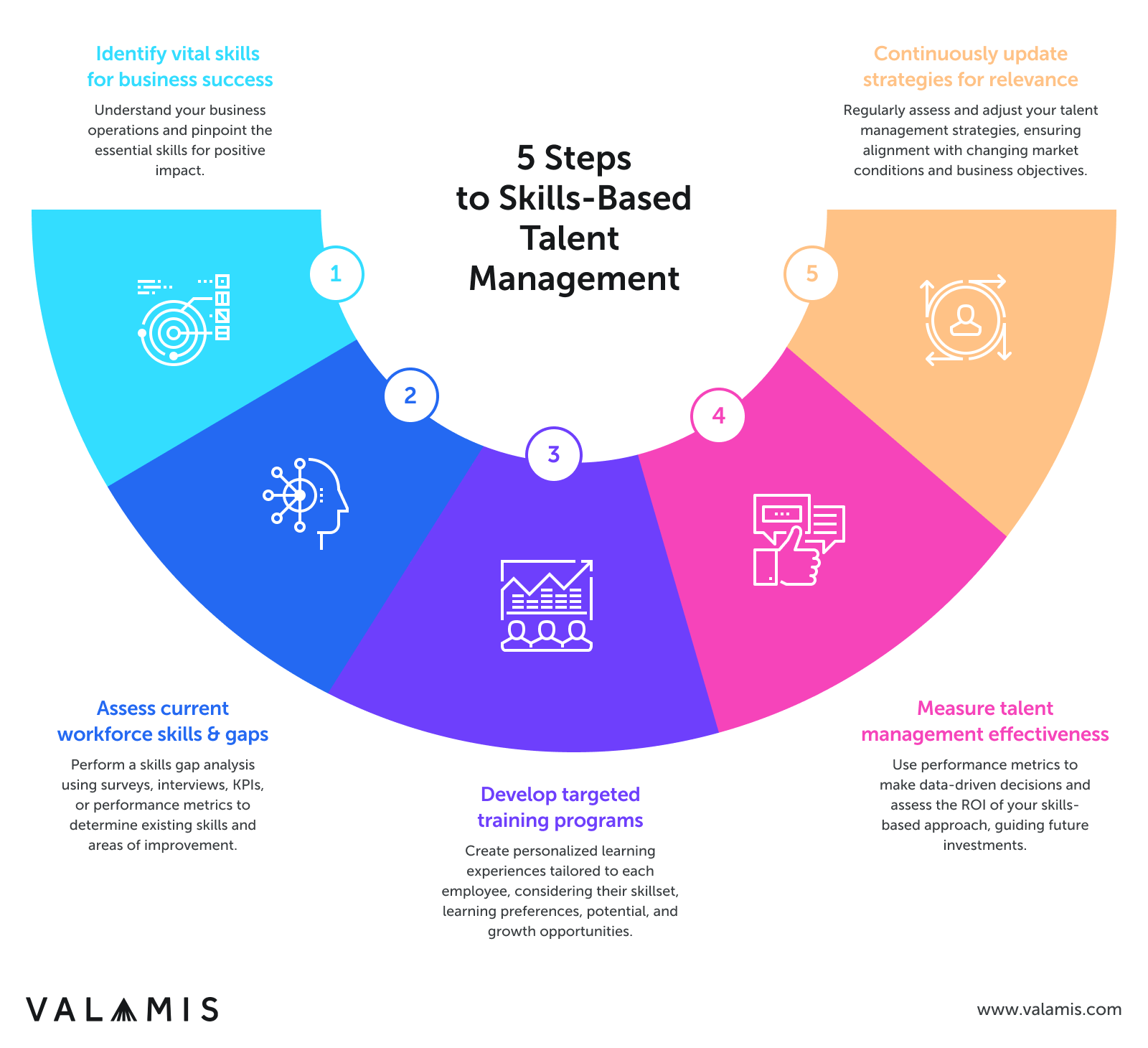
1. Identify the skills you need
The first step is understanding how your business runs and the skills vital to your success.
How should employees behave at your business, and what do they need to know to have a positive impact?
You cannot manage a workforce using a skills-based approach without identifying your needed skills.
2. Assess the skills of your current workforce
Next, you have to determine the skills of existing employees and determine any gaps that are present. This process is called skills gap analysis.
It can incorporate several methods, such as surveys and employee interviews, or a more analytical approach based on KPIs and employee performance metrics.
Many learning solutions, including Valamis, provide the functionality needed to assess the skills of a workforce effectively.
Organizations can efficiently perform skills gap analysis using a single tool with the right technology, from maintaining skills matrices and identifying gaps to competency management and implementing targeted skills-based training.
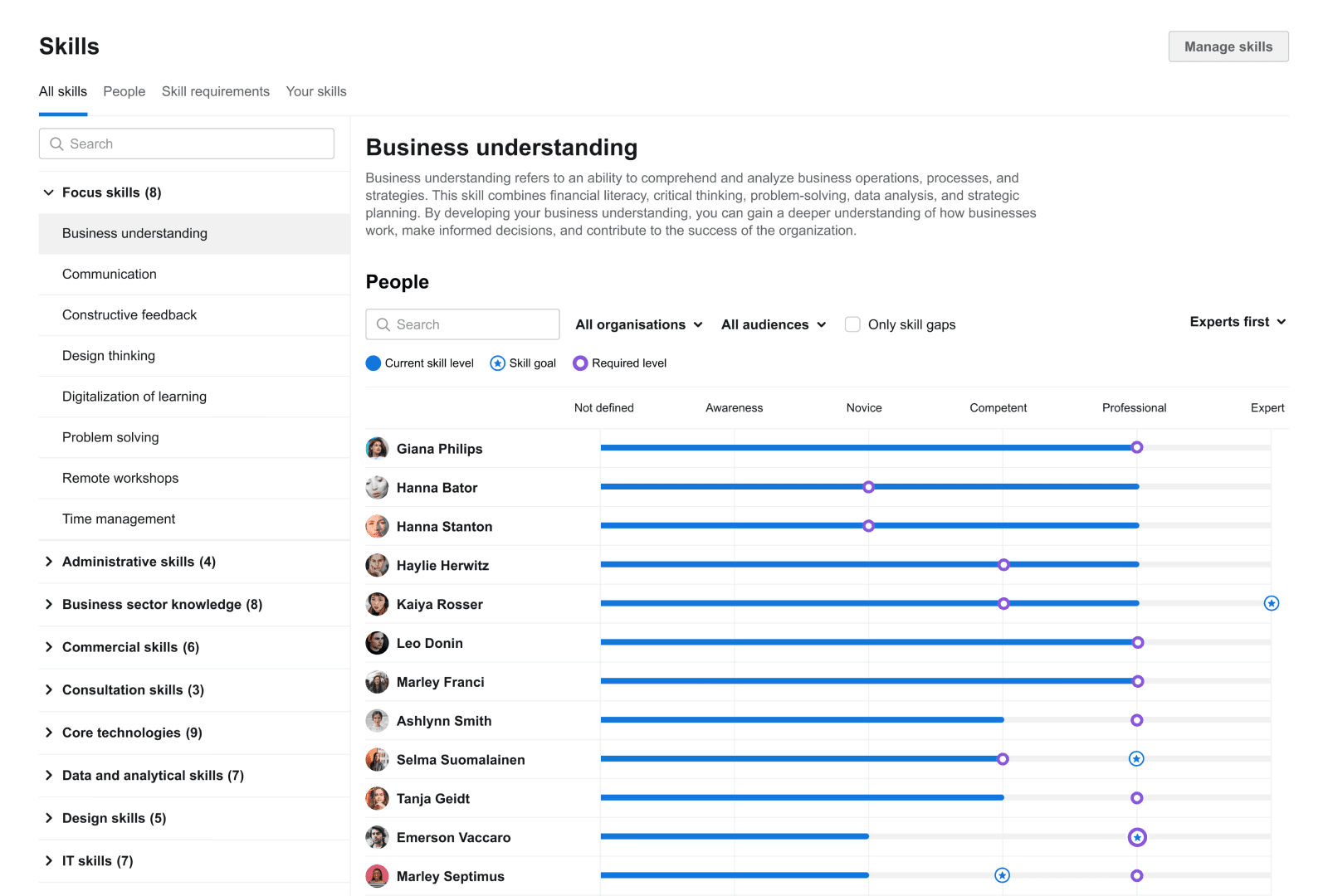
3. Develop targeted training and development programs
Once you know the gap between the skills you want from your workforce and what you currently have, you can develop targeted Learning and Development (L&D) programs to meet your needs.
This means personalized learning experiences tailored to each employee based on their existing skillset, how they like to learn, where they show potential, and the opportunities for growth that would be most beneficial for the company.
4. Measure the effectiveness of talent management programs
While you subjectively assess the success of your transition to a skills-based approach, it is better to incorporate performance metrics to make data-driven decisions.
By measuring the output of individual employees and the organization, you can determine whether the new skills-based approach to talent management is worth the investment.
Additionally, you can decide where to invest your time and money moving forward.
Read: 10 Learning and Training Metrics to Know
5. Assess and update your talent management strategies
This assessment should not be a one-time thing.
Market conditions and the businesses that operate in them are both constantly changing. You must continuously assess and update your talent management strategies to ensure success.
Ensuring they remain relevant and aligned with current business objectives.
The role of HR and L&D leaders when taking a skills-based approach to talent management
HR and L&D leaders are critical to the success of skills-based talent management.
They are the ones affected the most by the transition, and they are the people who have to put in the work to implement the new processes.
Additionally, they must be cheerleaders for the transition, motivating stakeholders about the benefits.
L&D teams must develop the new skills-based training programs, and HR must oversee the process, acting as a central hub for the new strategy.
Key responsibilities for HR and L&D leaders include:
- Identifying skills gaps – working closely with management, L&D leaders must identify the skills gaps in the organization. Various tools are available to help them achieve this, including surveys, assessments, and performance metrics.
- Developing training programs – once skills gaps are identified, it is the responsibility of the HR and L&D staff to develop targeted training programs to address them. This can include a mix of formal training programs, on-the-job learning, coaching, mentoring, and other learning initiatives.
- Measuring the impact – tracking the impact of training programs on employee performance and business outcomes can be challenging. But HR and L&D departments have a range of data analytics tools to help assess ROI, engagement, and retention.
- Collaborating with business leaders – management sets the business’s strategic priorities, but it is down to HR and L&D leaders to make them a reality. Aligning talent management with the broader goals of the organization.
- Fostering a learning culture – the learning culture at a company is the result of many factors, but the most important is the L&D development team. They can encourage employees to take ownership of their learning, share knowledge, and create development opportunities.
How learning platforms can support skills-based talent management
Learning platforms (including LMS, LXP etc) are a vital tool for aiding the transition to skills-based talent management.
They offer a range of functionality for improving the effectiveness of skills-based training, but they also provide a critical source of data to assess that effectiveness in the first place.
Learning platforms are vital for businesses looking to implement:
1. Personalized learning
Learning platforms allow organizations to deliver personalized learning experiences to fit an employee’s skills gaps and learning preferences.
This includes assessments to identify skill gaps and then curating or recommending relevant content accordingly.
2. Upskilling and reskilling
With technology to help, you can provide vast training resources to develop new skills and competencies.
This covers everything from soft skills to technical skills or assisting employees to stay updated with developments in their field.
3. Greater accessibility
Implementing a learning platform with cloud-based training material allows employees to access it whenever and wherever they want – helping them learn at their own pace and on their own schedule regardless of location.
This is particularly important for businesses with remote workers or global workforces operating across multiple time zones.
4. Data analytics
Technology offers a treasure trove of data on the employee learning experience needed for detailed analytics.
Gaining insights into each employee’s progress, the skills they are acquiring, identifying trends among the workforce, and looking for areas to improve.
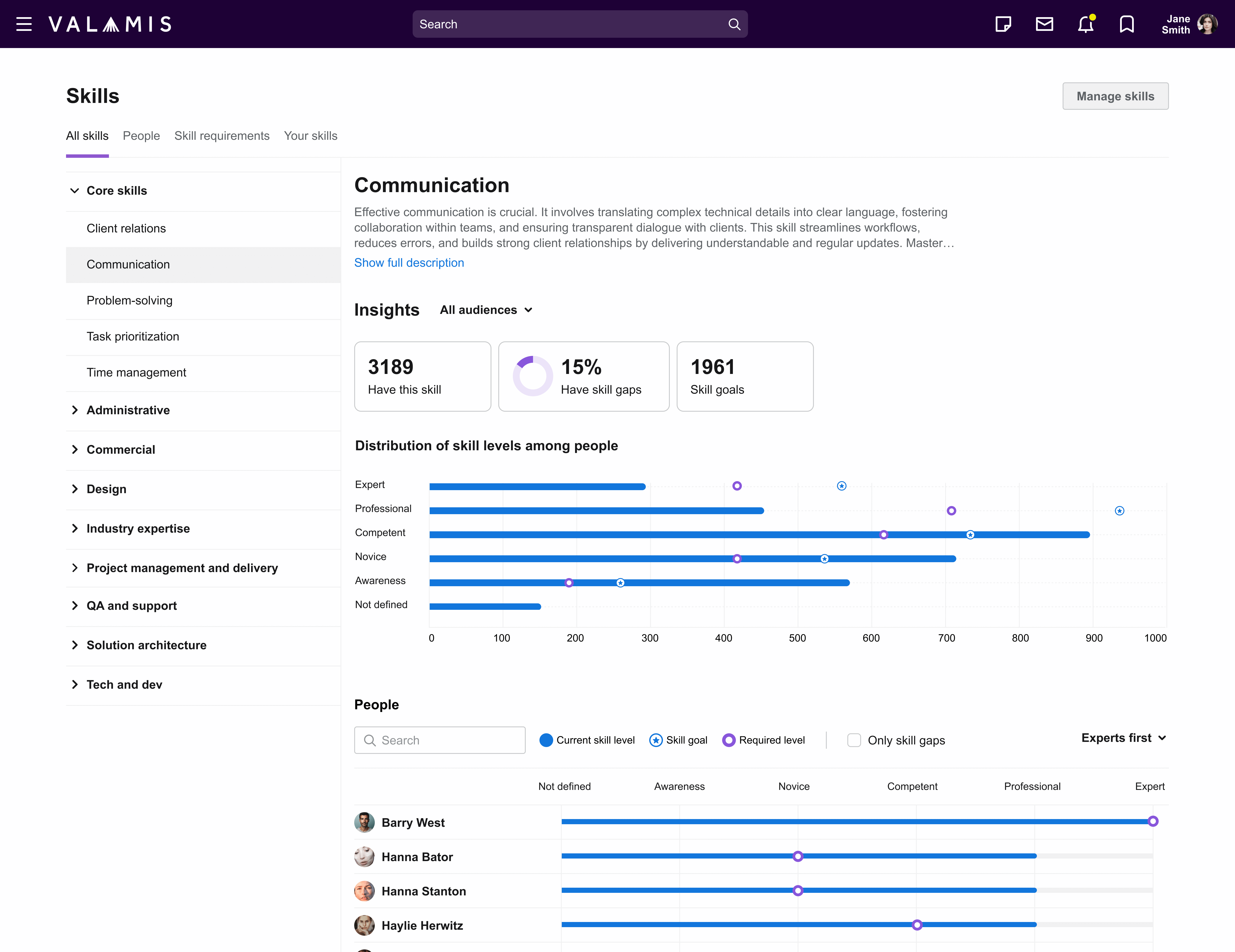
5. Collaborative learning
Social or collaborative education can help improve training effectiveness, with employees sharing information or encouraging each other to continue learning.
Learning platforms increase the opportunities for collaborative learning, providing a tool for communication, the sharing of knowledge, or for use as an organizational tool, getting people together to work through training material.
Conclusion
Focusing on skills over roles allows businesses to deploy their employees for the best outcome. Choosing the work people should do based on real-time meritocracy, not past achievements. Additionally, businesses can manage their workforce and design training programs based on the skills they currently have access to and what they want to acquire in the future.
The future of talent management is a skills-based approach. Businesses already incorporating skills-based talent management are seeing significant benefits with greater organizational agility and more effective workforces. Those sticking to traditional roles-based mindsets risk being left behind at a time when the business world is going through significant changes.
However, skills-based talent management is only successful when organizations can accurately assess the skillset of existing employees and potential candidates. Many of the challenges associated with skills-based approaches can be overcome by integrating an advanced learning solution, such as Valamis. Our solution allows you to maintain up-to-date skills matrices for each employee and develop personalized training programs that overcome any potential gaps moving forward.




